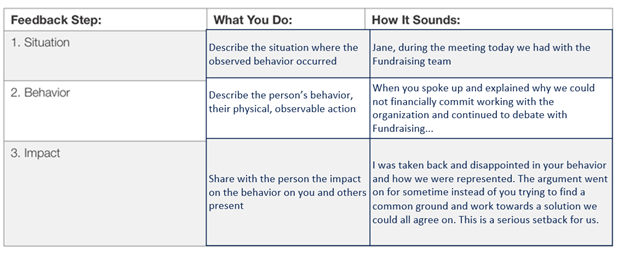The word “feedback” triggers mixed emotions. For some, it is an opportunity to learn, improve, and grow. For others, it can feel like going to the dentist… a necessary evil, a feeling of I am not good enough, and being stressed. As a leader, giving feedback to your team, peers, or your boss can appear hard and scary.
It is one of the most difficult and necessary skills to apply consistently well. Giving effective feedback is a core skill required of anyone engaged in the development of individuals. It does not have to be hard and scary. It’s about having a growth mindset and how we communicate it.
In this blog, we discuss:
- what is feedback
- how can you give feedback
- what are tips on providing and seeking feedback
WHAT IS FEEDBACK?
When you think of feedback, at times we have a common mindset: I give feedback so I can fix people’s problems vs. a growth mindset: I give and seek feedback so I can elevate the team. The later statement is positive and creates a “two-way” discussion between the feedback provider and receiver. The former associates feedback with negativity and one-directional.
Feedback is defined as:
- Information ‘fed back’ to a person after an action or behavior has been observed or validated through credible resources.
- Communication about objective observations or information regarding a person’s behavior and its’ effect on you and others.
- The most powerful tool you have to shape desirable behaviors and change less effective behaviors.
HOW CAN I GIVE FEEDBACK?
I practice the SBI Model (Center of Creative Leadership): Situation, Behavior, and Impact. SBI provides a structure that helps keep your feedback focused and relevant, and increases the likelihood it will be received in a clear, non-defensive manner by the recipient.
Here is the SBI framework to give feedback:

- Situation: Explain the situation. Anchors the feedback in time, place, and circumstances. The more specific you can be about the where and when, the better.
- Behavior: Describe the feedback receiver’s behavior. Helps the individual understand exactly the behavior you’re talking about. Think of playing back your video recording, only using words to describe what you saw. Avoid judgments here, such as, “You weren’t listening to me.” Instead, simply describe the person’s behavior: “When I was talking, you pushed your chair away from the table and gazed out the window.”
- Impact: Share with the individual the impact of the behavior on you and/or on others who were present. Impact is what you or others experienced; you’re now making that internal experience known to the individual. In an organizational and work context, the impact of the behavior can include work outcomes, client satisfaction, work team, and/or the larger organization and business. It can also include the impact on the individual who demonstrated the behavior; in essence, the consequences or result of their behavior on their reputation, perceived professionalism, capability, etc.
Most often, a description of the impact will start with, “I felt …” or, “I was” or, “It appeared to me others were …”. If you find yourself saying, “You were …”, you’re probably on the wrong track. An impact statement is not an interpretation of why the individual showed that behavior, and it is especially important not to label the behavior in a psychological way or to make a judgment about the person.
Situation and Behavior statements are about the feedback receiver. Impact statements are about the feedback giver, others involved, or the organization – NEVER about the feedback receiver.
Example:

WHAT ARE TIPS ON PROVIDING & SEEKING FEEDBACK?
Check out the Dos/Don’t Tip Sheet for providing feedback.
Feedback is a “two-way” street. To be an effective leadership, you should also seek feedback. This shows that you value them as professionals and what they have to say. (Not to mention it starts creating a culture of feedback …more to come in our next blog).
Here are 5 tips on seeking feedback:
1. Declare your intent – Let the other person know why you want feedback. Your intent is typically to learn, develop, and get better as a professional.
2. Ask for specific feedback – Avoid asking questions that won’t generate useful information. Generic questions like “How am I doing?” won’t give you any specific insight. Instead ask:
- “I’ve been working on ____. How could I get better?”
- “What specifically, do we need to do better with respect to ____. (system, structure, process)?”
- Listen empathically – Listen to understand, not to explain or defend yourself.
3. Acknowledge the feedback
- “I am grateful for your specific observations. They are very helpful. This what I plan to do.”
4. Evaluate the feedback – Use good judgement to determine what to do with the feedback.
5. Commit to action – Make commitments carefully and keep them at all costs. Say what you are going to do and then do it.
In conclusion…
I encourage you to try the SBI model and apply the tips in your next conversation. Practice makes progress! We would love to hear how it went on our LinkedIn page.
